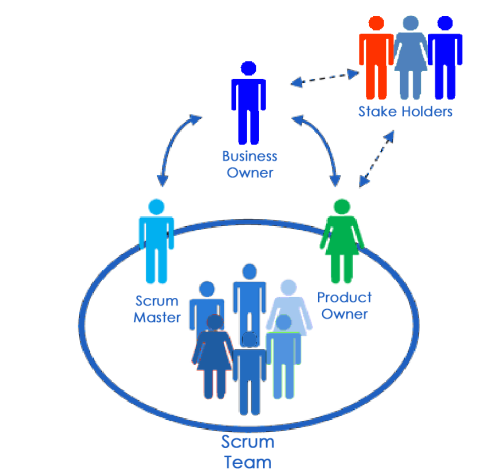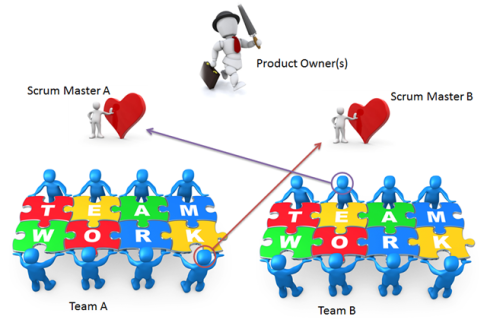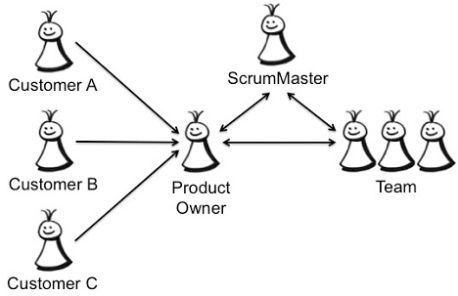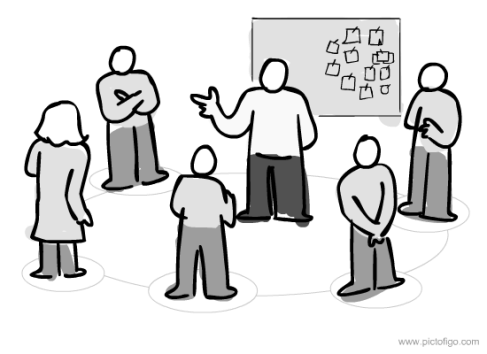What is a SCRUM TEAM?
Scrum highly relies on a highly motivated, closely collaborating, cross-functional and self-organized teams. Scrum is not a full process or methodology, it is a framework. It does not provide a complete, detailed descriptions of how everything is to be done. The Scrum team is given the power of deciding how most of the things should be done. The team will know best how to solve the problem as they are presented. This flexibility is the key success factor of the Scrum.
The Scrum Roles
The three core roles of the members of a Scrum team are:
§ The Product Owner
§ The Scrum Master
§ The Scrum Team
PRODUCT OWNER
In Scrum, the Product Owner is the one person responsible for a project’s success. The Product Owner leads the development effort by conveying his or her vision to the team, outlining work in the scrum backlog, and prioritizing it based on business value. Of course, he or she must also consider the stakeholders (to make sure their interests are included in the release) and the team (to make sure the release is developed by the deadline and within budget). As such, the Product Owner must be available to the team to answer questions and deliver direction.
But this combination of authority and availability to the development team makes it hard for the Scrum Product Owner not to micro-manage. Scrum values self-organization and, as a result, the Product Owner must respect the team’s ability to create its own plan of action. This means that a Product Owner is forbidden to give the team more work in the middle of the sprint. Even if requirements change or a rival organization unveils a new product that renders the team’s work all for naught, the Scrum Product Owner is discouraged from altering the sprint until the next sprint planning meeting. However, the Product Owner may cancel a Sprint when necessary. One Product Owner I know cancels Sprints once or twice per year tops.
Furthermore, it is the Product Owner’s responsibility to consider which activities will produce the most business value. This means making tough decisions—that the team might not appreciate—during sprint planning. However, the Product Owner is the one person who must face the music if the project crashes and burns. Therefore, he or she must aggressively determine which features of a product are most important, when they are developed, etc. Just as the development team must produce the negotiated work for the Product Owner, the Product Owner must deliver the product to the customer.
Responsibilities of a Product Owner in a Scrum Team
§ The product owner decides what will be built and in which order
§ Defines the features of the product or desired outcomes of the project
§ Chooses release date and content
§ Ensures profitability (ROI)
§ Prioritizes features/outcomes according to market value
§ Adjusts features/outcomes and priority as needed
§ Accepts or rejects work results
§ Facilitates scrum planning ceremony
SCRUM MASTER
In Scrum, the Scrum Master is an arduous role and demands a distinct personality type to succeed. The best Scrum Masters are real team players, who receive as much satisfaction from facilitating others’ success as their own. They must also be comfortable surrendering control to the Product Owner and team. For those two reasons, traditional project managers don’t usually make great Scrum Masters.
So, specifically, what does a Scrum Master do? First and foremost, the Scrum Master removes any impediments that obstruct a team’s pursuit of its sprint goals. In other words, the Scrum Master does everything he or she can to facilitate productivity. When a developer’s computer dies, it’s the Scrum Master’s job to get it back up and running—or get another one. If developers are complaining about the high temperature in the team room, the Scrum Master must find a way to cool it down. It might be easy to summarize a Scrum Master’s work in a sentence or two, but scenarios he or she could face are truly infinite.
The second role for the Scrum Master is to own the success of the teams process. This might means helping the Product Owner maximize productivity or helping the team turn the sprint retrospective meeting into an evolutionary / Kaizen experience. Facilitating for the team or Product Owner might also include tasks like helping maintain the backlog and release plan or radiating Scrum artifacts to ensure the Product Owner or The Team is informed about progress.
Responsibilities of a Scrum Master in a Scrum Team
PROCESS related responsibilities;
In one line he is responsible for the entire Scrum process – Leader and motivator about doing Scrum:
§ ensures Artifact quality
§ helps and coaches Roles to do their job: product owner, customer, developers
§ ordering of activities, meetings, time-boxes
§ sets up, conducts and facilitates ALL meetings
§ ensures Engineering practices are followed
§ Ensures the Team has a good social context, a good environment, and it is SWARMING!
§ Enforces ALL rules
§ Promotes ALL values: transparency, honesty, courage
§ Insurance for “doing things right. Intervene only if necessary!
TEAM related responsibilities;
Flips between Coach, a Watchdog, a Mentor and a Project Manager, Rep to Management
§ Recommends or finds initial members of team
§ Responsible for team balance: how many BAs, developers, testers, etc. of what kind?
§ The Scrum Master is responsible for setting the team up for success
§ Removing the barriers between development and the customer so the customer or the user directly drives development
§ Ensuring team actually did what they said they would do: checking testing reports, etc.
§ Balancing the team workload – e.g. pass work to early finishers
§ Shielding the team from outside disturbances
§ Removing Impediments and resolving issues
§ Promoting creativity, collaboration and knowledge sharing
§ Improving the lives of the development team e.g. flexible hours, flexible days, payback for heroics, etc.
§ Improving the productivity of the development team in any way possible: training, tools, system-level things
§ Improving the engineering practices and tools so each increment of functionality is potentially shippable
§ Promote team pride
§ Organizes Celebrations after releases or sometimes after Sprints
CUSTOMER related responsibilities;
§ Teaches the customer how to maximize ROI and meet their objectives through Scrum
§ keeping ongoing communication with the customers
PO related responsibilities;
§ Responsible for training and keeping ongoing communication with Product Owner (good PB!)
ADMIN related responsibilities;
§ Maintaining the Sprint Backlog and producing Sprint Burndowns
§ Posting the Sprint Burndown as Visible Status: Wall, Wiki, email, etc.
§ Ensuring Scrum Board gets updated
MANAGEMENT related responsibilities;
§ representative to team for management
MULTI-TEAM related responsibilities;
Participating in the Scrum of Scrums such that both how their team affects other teams, and how other teams affects his team are understood, if no other team member is available
§ Coordinating participation of their team in either the “big room” Sprint Planning Meeting, or in a staggered Sprint Planning Meeting understanding dependencies, or coordinating with architects when they exist
§ Coordinating participation in the Sprint Review Meeting, both independently and with the rest of the multi-team, the latter is specially important in releases to production where many dependencies exist
§ Coordinating with integration Sprints when they exist
§ Coordinating integration issues with other Teams
§ Working with their team or theme PO and with the CPO (chief product owner), to ensure their teams can choose portions of the Product Backlog (usually though themes)
§ Coordinating with their individual teams on dependencies or modified work found at the Scrum of Scrums
SCRUM TEAM
The Scrum Team is responsible for the high-quality and timely delivery of sprint commitments in line with the expectations of the Product Manager and Product Owner.
The Scrum Team is cross-functional and multi-skilled- they know their strengths and work together to support each other through challenging times. They’re not all experts in every area, however between them they have a wide range of abilities and areas of expertise.
The Scrum Team takes responsible for their commitments and are held singularly accountable for their actions and decisions – they are as one.
The Scrum Team works closely with their Product Manager – approaching him/her for guidance and confirmation and reassurance/acceptance during the course of the Sprint. The Scrum Team demonstrate their output to the Product Manager and relevant Product Owner(s) and Stakeholders at the end of each Sprint – this is when they are granted/denied approval for having achieved their pre-agreed Sprint Objectives.
Do not misunderstand a scrum team with a normal development team. A Scrum team is special in it’s nature and capabilities.
Responsibilities of a Scrum Team in a Scrum Team
§ Help prioritizing the sprint backlog
§ Estimate the effort to implement User Stories
§ Development to achieve sprint goals.
§ Implementing test cases
§ Unit and initial Acceptance testings
§ Identify obstacles and informing the Scrum Master
§ Self organizing
§ Daily Scrum meetings
A scrum team comprised of cross-functional members who are capable of achieving the sprint goals. This could include software engineers, architects, programmers, analysts, system admins, QA experts, testers, UI designers, etc. Key skills of a scrum team member should be:
§ Pair Programmer
§ Understands TDD, BDD, etc
§ Understands Code smells and Refactoring
§ Continuous Integration
§ Self-motivated and organized
§ Team player
M.G.K
References;
http://www.agiledevelopernotes.com
http://top7business.com
http://stackoverflow.com
http://scaledagileframework.com
http://scrummethodology.com
http://www.ontimenow.com
http://www.romanpichler.com
http://blog.agilebuddy.com
http://scrummethodology.com
http://www.romanpichler.com
http://www.scrumalliance.org
http://agile101.net
http://scrummethodology.com









[…] Image from https://milindageorge.wordpress.com/2013/03/26/an-agile-team-scrum-team-roles-responsibilities/ […]